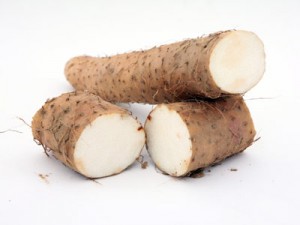
Prime Health Channel. (2014). Wild Yam. Retrieved from: http://www.primehealthchannel.com/wild-yam.html
Botanical Name: Dioscorea villosa
Common name: Wild Yam (Hoffmann, 2003, p. 543)
Family: Dioscorea (Bone, 2003, p. 464)
Parts used: Root and rhizome (Braun & Cohen, 2010, p. 1024)
History/Folklore: Once the herb was used as a source of diosgenin used to produce artifical progesterone in the manufacturing of contraceptive hormones (Hoffmann, 2003, p. 543; Braun & Cohen, 2010, p. 1024). It is to be noted that the conversion of diogensin needed to produce progesterone cannot occur in the human body and therefore Wild Yam is not a source of progesterone (Braun & Cohen, 2010, p. 1024).
Constituents: Diosgensin, dioscin, dioscorin, vitamin C, beta-carotene, Vitamins B1 and B3, iron, magnesium, potassium, selenium, zinc and polyphenols (Braun & Cohen, 2010, p. 1024).
Actions
- Antispasmodic (Hoffmann, 2003, p. 543)
- Anti-inflammatory (Hoffmann, 2003, p. 543; Bone, 2003, p. 464)
- Antirheumatic (Hoffmann, 2003, p. 543)
- Hepatic (Hoffmann, 2003, p. 543)
- Cholagogue (Hoffmann, 2003, p. 543; Braun & Cohen, 2010, p. 1024)
- Diaphoretic (Hoffmann, 2003, p. 543)
Indications
- Intestinal colic (Hoffmann, 2003, p. 543)
- Bilous colic (Hoffmann, 2003, p. 543)
- Diverticulitis (Hoffmann, 2003, p. 543)
- Dysmenorrhea (Hoffmann, 2003, p. 543)
- Neuralgic dysmenorrheal (Hoffmann, 2003, p. 543)
- Ovarian neuralgia (Hoffmann, 2003, p. 543)
- Ovarian and uterus pain (Hoffmann, 2003, p. 543)
- Acute phase of rheumatoid arthritis (Hoffmann, 2003, p. 543; Bone, 2003, p. 464)
- Pains of pregnancy and associated nausea and vomiting (Hoffmann, 2003, p. 543)
- Alleviation of menopausal symptoms (Bone, 2003, p. 464)
Dosage & Preparation:
- Decoction of dried root (2-3g/tds)
- 1:5 Tincture (2-10mL/tds) (Braun & Cohen, 2010, p. 1025)
- 3-6mL liquid extract (1:2)/day or 20-40mL/week (Bone, 2003, p. 464)
Cautions: Due to saponin content, may cause irritation of gastric mucosa (Bone, 2003, p. 464)
Combinations:
- For intestinal colic: combines with Acorus calamus, Matricaria chamomilla and Zinziber officinale.
- For rheumatoid arthritis: combines with Actaea racemosa (Hoffmann, 1990, p. 241)